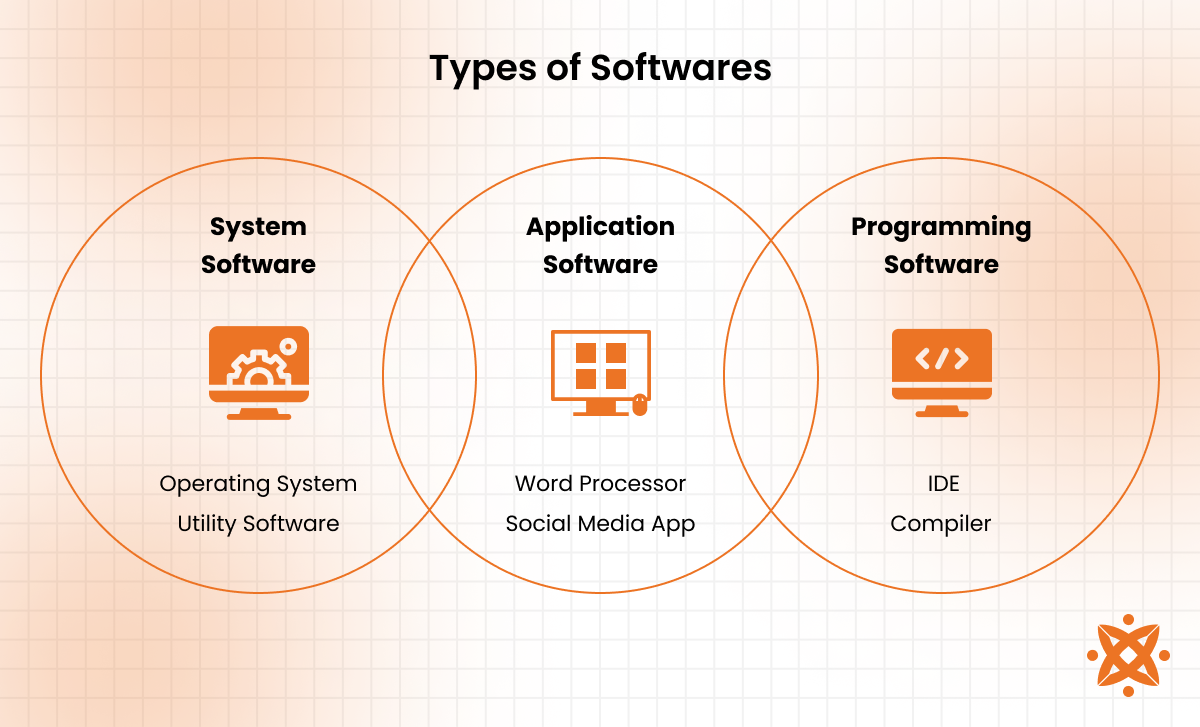
Software development involves creating, testing, and maintaining applications designed to solve specific problems or provide functionality. It encompasses a wide range of activities, from writing code in various programming languages to rigorously testing the software to ensure that it meets user needs. According to Industry ARC, the UK Software Development market was $53.89 billion in 2023 and is projected to reach $70.99 billion by 2030, growing at a CAGR of 3.9%.
The different types of software development include frontend and backend development, mobile app development, and cloud-native development.
Front-end development focuses on the user interface and experience, while back-end development concerns server-side logic and database management. Mobile app development creates applications for mobile devices, and cloud-native development builds apps that are optimised to run in cloud environments, leveraging services like ApplicationProgramming Interfaces (APIs) for effortless integration.
The common use cases of software development include enterprise resource planning (ERP) software, which helps businesses manage operations, and artificial intelligence (AI) applications, which automate decision-making processes. Cloud computing services, which offer scalable infrastructure for businesses, and cybersecurity software that protects data and systems are also key examples where software development plays an integral role.
The common methodologies used in software development include Agile methodology, Waterfall, and DevOps practices.
Agile methodology emphasises iterative development, where software is released in stages, allowing for frequent updates and improvements based on user feedback. Waterfall is a more linear, sequential approach to development.
DevOps practices promote collaboration between development and operations teams to ensure continuous integration and deployment, improving software reliability and speed.
The 7 steps involved in the software development process are planning, requirements gathering, system design, implementation, testing, deployment, and maintenance.
The software development lifecycle begins with identifying user needs, followed by designing and coding the solution, and ends with testing, deployment, and continuous monitoring. Throughout the process, version control systems are used to manage changes to the software, ensuring all changes are tracked and rolled back if necessary.
- What is Software Development?
- What is Software Design?
- What are the Different Types of Software Development?
- What are the Use Cases of Software Development?
- What are the Common Software Development Methodologies?
- What Steps Are Involved in the Software Development Process?
- What is the Difference Between Software Development and Apps Development?
- What is the Difference Between Software Development and Web Development?
- How To Choose a Development Software Company?
- What are the Software Development Best Practices?
What is Software Development?
Software development is the process of creating, designing, testing, and maintaining software applications or systems to meet specific user needs or business goals. It involves writing code using programming languages, organising workflows, and developing algorithms to create functional software.
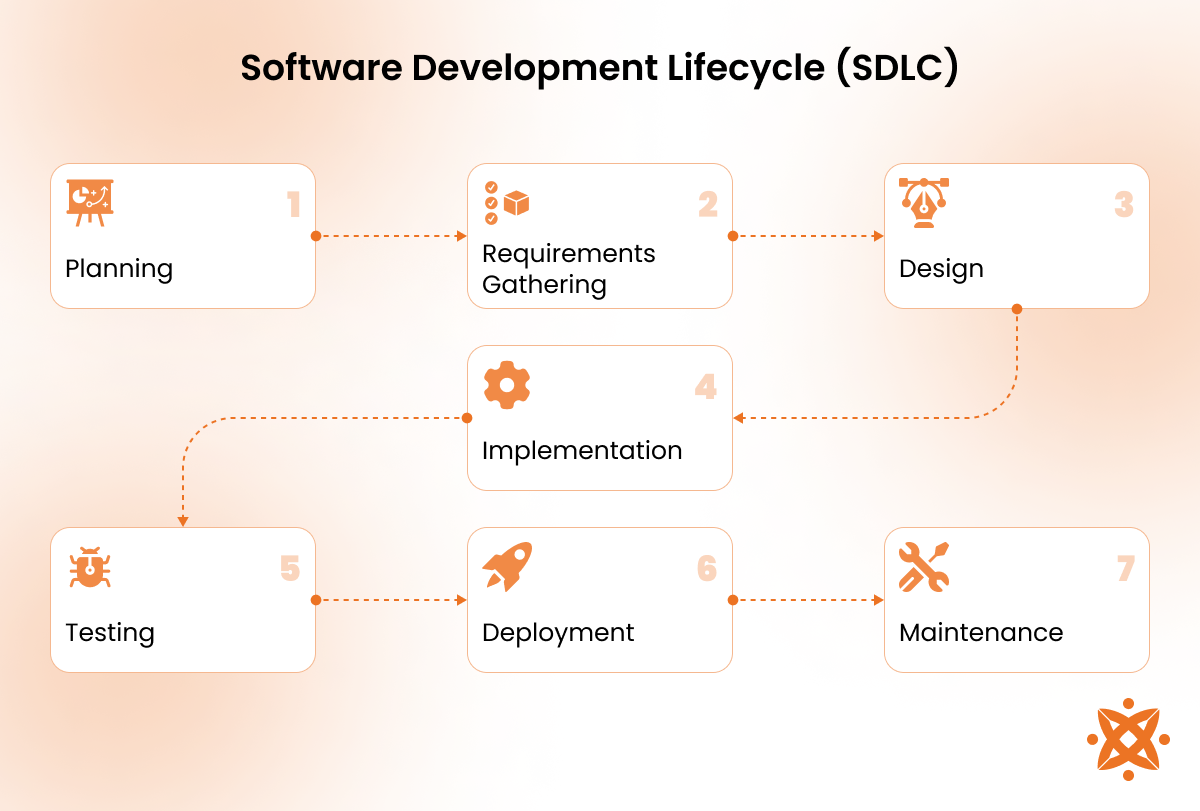
This process addresses a wide range of applications, from mobile apps and web platforms to enterprise systems and AI-powered solutions, and it forms the backbone of modern digital infrastructure.
Software development involves a series of defined stages, referred to as the software development life cycle (SDLC). It starts with requirement analysis to understand the problem or need, followed by designing the architecture that outlines the software's structure. Then, the application is coded, and regular testing is used to identify and fix bugs.
Once the software is deployed, developers provide updates and maintenance to ensure its continued effectiveness. Tools like version control systems, automated testing frameworks, and cloud-based IDEs are integral to facilitating the process and enhancing collaboration among teams.
Software development began in the 1940s with machine-level programming for early computers. By the 1950s, high-level programming languages like Fortran and COBOL simplified coding, making software development more accessible. The following decades saw the emergence of structured programming, graphical user interfaces (GUIs), and object-oriented programming, which enabled the development of more complex systems.
In the 21st century, advancements in cloud computing, mobile app development, and artificial intelligence have revolutionised the field, making software an important component of everyday life. Today, software development continues to evolve, emphasising speed, scalability, and innovation.
The software development industry has grown exponentially due to the increasing reliance on technology in personal and professional spheres. Developers are some of the most in-demand professionals globally, with the field encompassing various roles, such as front-end developers, back-end engineers, and full-stack specialists.
Languages like Python, JavaScript, and Java are popular due to their versatility and robust ecosystems. Emerging technologies like blockchain, low-code platforms, and machine learning are reshaping software design and implementation, offering new opportunities and challenges for developers worldwide.
In the UK, software development is a leading industry that contributes significantly to the economy. According to Industry ARC, the UK Software Development market was $53.89 billion in 2023 and is projected to reach $70.99 billion by 2030, growing at a CAGR of 3.9%.
What is Software Design?
Software design is the process of defining the architecture, components, interfaces, and data structure of a software system to meet specified requirements.
Unlike software development, which focuses on coding and building the system, software design emphasises planning and problem-solving to create a blueprint for growth. This stage ensures the software's functionality, usability, and scalability and addresses the technical and user-centric aspects of the project.
What is Software?
Software is a set of instructions, data, or programs used to operate computers and execute specific tasks. It is categorised into system software, such as operating systems like Windows or Linux; programming software, including compilers and debuggers; application software, like Microsoft Word or social media apps; and embedded software, used in devices like smart thermostats or automotive systems.
System Software manages hardware resources and provides fundamental services, serving as the foundation for other software. Examples include operating systems and utility programs that facilitate tasks like file management or disk cleanup.
This type of software allows users to interact with hardware efficiently and ensures the effective functioning of application software. In contrast to other software types, system software operates in the background without direct user intervention.
Programming Software aids developers in writing, testing, and debugging their code. Tools like compilers, interpreters, and IDEs (Integrated Development Environments) fall under this category. Unlike application software, which is intended for end users, programming software is designed specifically for developers to simplify the coding process.
Application Software is built for end users to perform specific tasks, from productivity tools like spreadsheets to entertainment platforms like video streaming services. These programs are user-centric and vary significantly in purpose, making them distinct from systems or programming software. For instance, while system software runs the device, application software enables users to achieve their goals, such as editing documents, playing games, or browsing the internet.
Embedded Software is designed specifically for devices with dedicated functions, such as smart TVs, medical devices, or automotive control systems. Unlike general-purpose software, embedded programs are designed to run on specific hardware, ensuring real-time responsiveness and efficiency. They are integral to the functionality of modern gadgets, allowing integrated operation in diverse environments, from homes to industrial settings.
Who Develops Software?
Programmers, software engineers, and software developers develop software. These professionals work collaboratively to design, write, test, and maintain software systems, ensuring they meet user needs and technical specifications.
The following individuals develop software:
- Programmers: Programmers focus on writing and debugging code using programming languages to implement specific functionalities within software applications. They primarily translate design specifications into executable programs.
- Software Engineers: Software engineers apply engineering principles to design and develop complex software systems. They manage the entire software lifecycle, including architecture, development, and optimisation, with a focus on reliability.
- Software Developers: Software developers combine programming and design skills to create, test, and deploy software applications. They oversee the project from conception to delivery, ensuring the software aligns with user requirements and business goals.
Why is Software Development Important?
Software development is important because it drives innovation, automates processes, and solves complex problems in various domains. It enables businesses to improve efficiency, deliver enhanced customer experiences, and stay competitive in a digital-first world.
Software development supports necessary areas like healthcare, education, and transportation, improving quality of life by providing customised solutions to modern challenges.
Software development is also important from a technical perspective because it facilitates the creation of scalable, secure, and efficient systems. Developers use advanced programming frameworks, algorithms, and tools to optimise resource utilisation, ensure data security, and improve system performance.
Modern software development practices, such as agile methodologies and DevOps, enable faster deployment cycles and continuous improvement. These practices ensure that applications meet ever-evolving user demands and technological advancements.
What are the Different Types of Software Development?
The different types of software development are cloud-native development, low-code development, and front-end development. These types represent distinct approaches and disciplines within the software development process, each focusing on different aspects of app creation, design, and deployment. They share the common goal of creating functional software, but their methodologies and areas of focus differ.
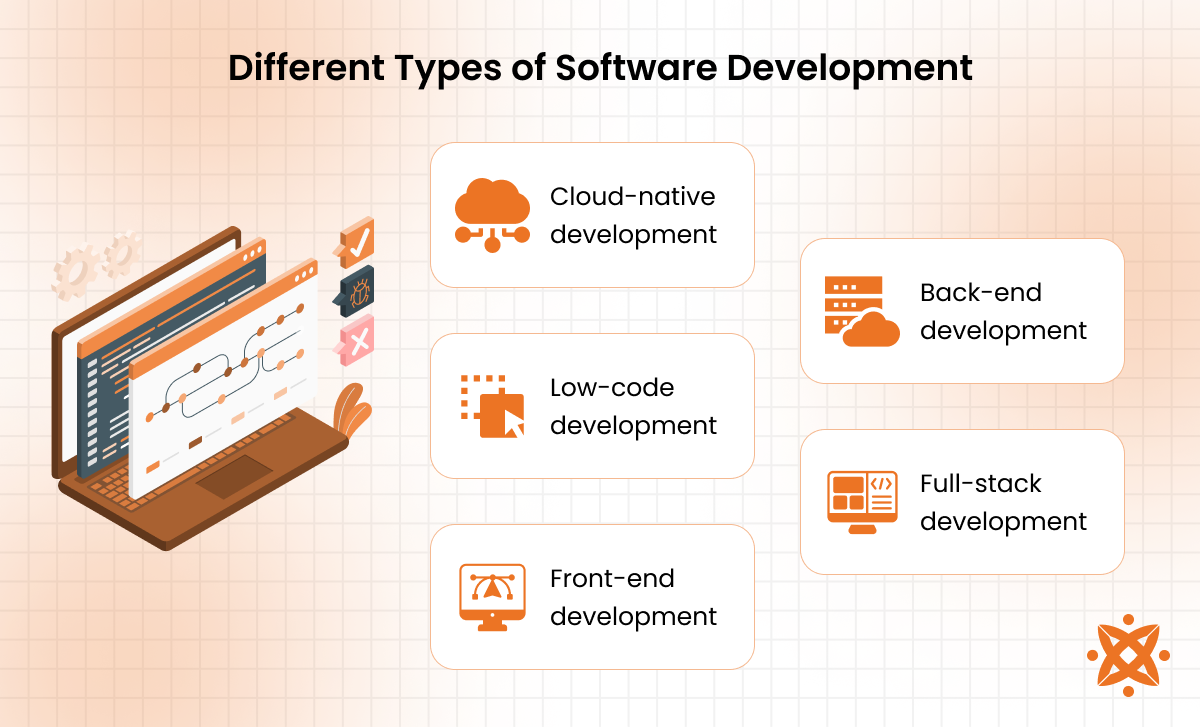
The different types of software development are as follows:
- Cloud-native development
- Low-code development
- Front-end development
- Back-end development
- Full-stack development
1. Cloud-native development
Cloud-native development involves building and deploying applications specifically designed to run in cloud environments. This approach leverages cloud services, such as compute power, storage, and databases, to maximise scalability, flexibility, and efficiency. Cloud-native applications are modular, built as microservices that are deployed, managed, and scaled independently. This development approach promotes faster time-to-market, resilience, and cost efficiency for organisations as they fully take advantage of cloud infrastructure.
2. Low-code development
Low-code development refers to the process of creating applications with minimal hand-coding using visual interfaces and pre-built templates. Developers and non-developers alike quickly design and deploy apps without extensive coding knowledge.
Low-code development expedites application delivery and empowers business users to create solutions that meet their needs, reducing dependency on traditional development teams. It offers speed and accessibility, but low code has limitations in terms of customisation and scalability for more complex applications.
3. Front-end development
Front-end development focuses on creating the parts of a web application that users interact with directly. It involves working with languages such as HTML, CSS, and JavaScript to build visually appealing, functional, and responsive user interfaces.
The goal of front-end development is to ensure a great user experience, meaning that the application should look and perform well across various devices and screen sizes. Front-end developers also integrate APIs and ensure smart interaction between the user and the underlying systems.
4. Back-end development
Back-end development deals with the server side of web applications. It involves working with databases, server logic, and API integration to ensure that the application functions properly, processes data correctly, and scales effectively.
Back-end developers use languages like Java, Python, Ruby, or PHP and are responsible for handling user authentication, data storage, and server management. A well-developed back-end ensures that applications are secure, responsive, and capable of handling large volumes of data and traffic.
5. Full-stack development
Full-stack development combines both front-end and back-end development into a single role, enabling developers to work on all layers of a web application. Full-stack developers are proficient in both client-side technologies (HTML, CSS, JavaScript) and server-side languages (Java, Python, Node.js). This all-encompassing approach allows for the development of complete applications from start to finish, offering flexibility and end-to-end control over the project.
Full-stack developers are highly valuable in agile environments, where rapid iterations and changes are frequent.
What are the Use Cases of Software Development?
The common use cases of software development are mobile applications, business and enterprise applications, and web development. These are just a few examples of how software development is applied across various industries to simplify operations, improve user experiences, and drive business growth.
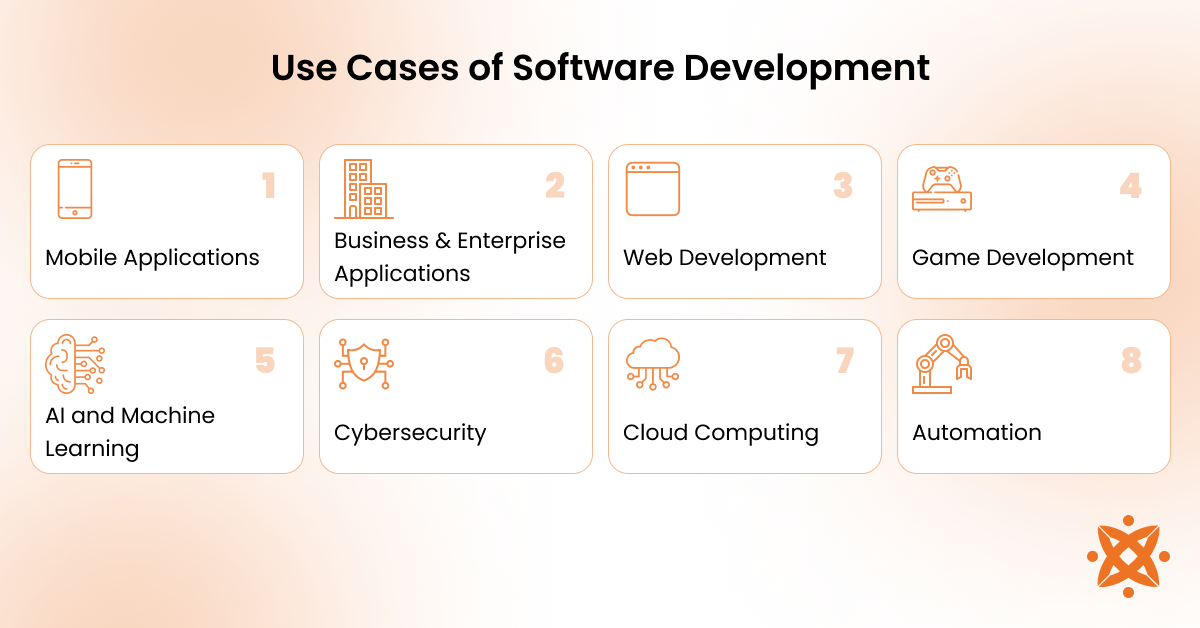
Each use case shapes the digital landscape, with software solutions customised to meet specific needs.
The use cases of software development are as follows:
- Mobile Applications
- Business and Enterprise Applications
- Web Development
- Game Development
- Artificial Intelligence and Machine Learning
- Cybersecurity
- Cloud Computing and Infrastructure
- Automation
1. Mobile Applications
Mobile applications are software designed to run on mobile devices such as smartphones and tablets. They provide a wide range of functions, from social media and entertainment apps to productivity tools and e-commerce platforms. These apps leverage the unique capabilities of mobile devices, such as touch screens, GPS, and cameras, to deliver personalised and interactive user experiences.
Mobile app development requires expertise in platforms like Android and iOS, as well as the ability to create intuitive user interfaces and ensure smooth functionality. Examples of successful mobile apps include social media apps like Facebook, messaging apps like WhatsApp, and e-commerce apps like Amazon.
2. Business and Enterprise Applications
Business and enterprise applications are developed to help organisations manage and facilitate their internal operations, improve productivity, and enrich customer relationships. These applications are designed to meet specific industry needs, such as accounting, inventory management, customer relationship management (CRM), and enterprise resource planning (ERP).
Software development for business applications focuses on scalability, security, and integration with other systems. For example, Salesforce is a widely used CRM platform that helps businesses manage customer data, track interactions, and automate marketing efforts. Enterprise applications are complex and require custom development to align with a company's specific processes and workflows.
3. Web Development
Web development involves creating and maintaining websites and web applications that run in a web browser. These range from simple static websites to complex web-based applications, such as online banking systems or e-commerce platforms. Web development involves front-end development (what users see) and back-end development (the server-side logic and database interactions).
Modern web development also focuses on responsive design, ensuring that websites and applications work effortlessly across different devices and screen sizes. The front end is developed using technologies like HTML, CSS, JavaScript, and various frameworks such as React and Angular, while the back end involves languages like Python, Ruby, or PHP. Examples include web-based email services like Gmail and online marketplaces like eBay.
4. Game Development
Game development is the process of creating video games for various platforms, including consoles, PCs, and mobile devices. This type of software development requires specialised knowledge of game mechanics, graphics rendering, and interactive storytelling. Game developers use game engines like Unity or Unreal Engine to create immersive environments, realistic physics, and engaging gameplay experiences.
Game development involves various technical skills, including programming, 3D modelling, animation, and sound design. Popular games like Fortnite, Minecraft, and Candy Crush are the result of extensive game development processes that combine art, technology, and creativity.
5. Artificial Intelligence and Machine Learning
Artificial Intelligence (AI) and Machine Learning (ML) are transformative technologies that enable software systems to mimic human intelligence and improve over time. AI and ML are used in applications such as natural language processing (NLP), image recognition, predictive analytics, and autonomous vehicles.
Software development in the AI/ML domain involves creating algorithms and models that analyse large datasets, make decisions, and learn from experience.
A common example is Amazon's recommendation engine, which uses machine learning to suggest products based on a user's browsing and purchase history. AI-powered chatbots like Siri and Alexa also rely on natural language processing and machine learning to understand and respond to user queries.
6. Cybersecurity
Cybersecurity software development involves creating programs and systems to protect data, networks, and devices from malicious attacks, unauthorised access, and data breaches. As cyber threats continue to evolve, developers must ensure that security measures are integrated into both software and hardware systems to safeguard user privacy and organisational assets.
Cybersecurity software includes antivirus programs, firewalls, and encryption tools. Norton and McAfee are well-known antivirus software companies that offer protection against malware and online threats. Data encryption tools like BitLocker and VPNs help secure online communication and protect sensitive data.
7. Cloud Computing and Infrastructure
Cloud computing software development focuses on creating applications and services that operate in cloud environments. This enables businesses to scale their operations without the need for on-premise infrastructure.
Cloud-based software applications and platforms allow users to access data and applications over the Internet, reducing the need for physical servers and storage devices.
Popular cloud platforms like Amazon Web Services (AWS), Microsoft Azure, and Google Cloud provide businesses with scalable, secure, and cost-effective solutions for hosting websites, managing data, and running enterprise applications.
Cloud computing allows companies to innovate quickly, access advanced technologies, and optimise resources without worrying about hardware management.
8. Automation
Automation software development focuses on creating tools and systems that automate repetitive tasks, workflows, and processes across various industries.
Automation helps businesses increase efficiency, reduce human error, and improve overall productivity. This includes automating data entry, customer service tasks, and business processes like inventory management or order fulfilment.
Robotic Process Automation (RPA) is a popular form of automation that uses software bots to mimic human actions, such as extracting data from documents or processing transactions. Tools like UiPath and Blue Prism are examples of RPA platforms that companies use to automate their operations and improve efficiency.
What are the Common Software Development Methodologies?
The common software development methodologies are Waterfall, Agile, and DevOps. These methodologies provide structured approaches for planning, designing, testing, and delivering software projects.
Each methodologies has its unique principles and advantages, catering to various project requirements and team dynamics and ensuring efficiency and quality in software development.
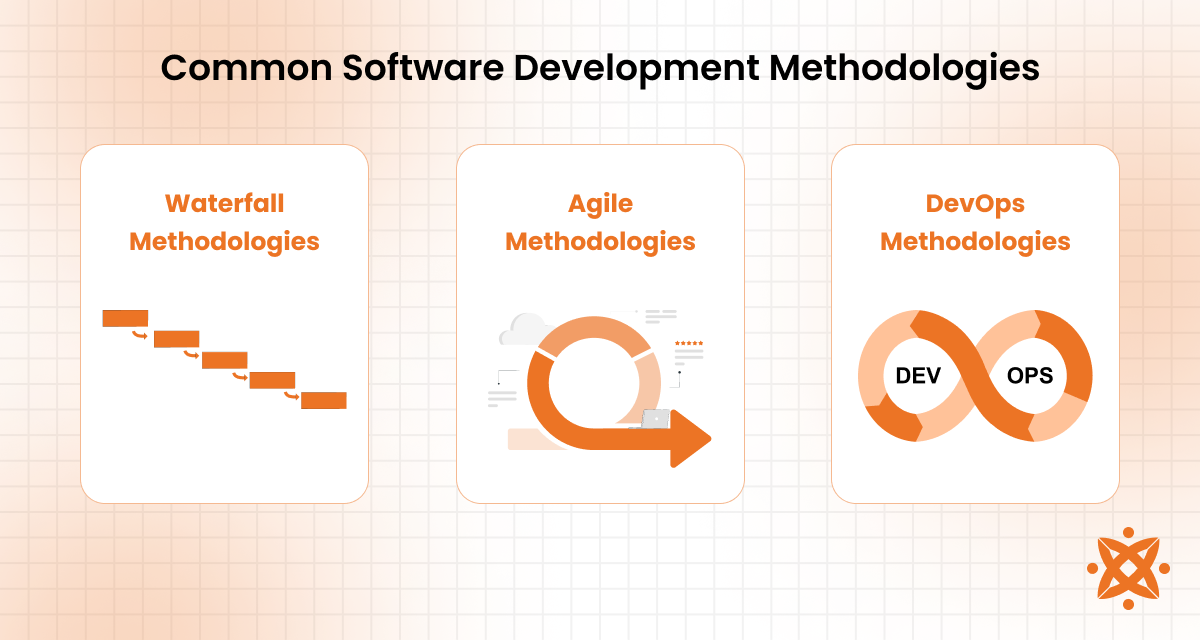
The common software development methodologies are as follows:
- Waterfall: The waterfall methodology is a linear, sequential approach to software development in which progress flows in one direction through phases such as requirements, design, implementation, testing, and maintenance. It is best suited for projects with well-defined requirements and minimal changes. Although it offers clarity and structure, it lacks the flexibility to accommodate evolving project needs.
- Agile: Agile is an iterative methodology that emphasises flexibility, collaboration, and customer feedback. Development occurs in small, incremental cycles called sprints, enabling teams to adapt quickly to changes and deliver functional software frequently. This method is ideal for projects where requirements are expected to evolve, promoting continuous improvement and stakeholder involvement.
- DevOps: DevOps combines development and operations to facilitate the software delivery process. It focuses on automation, integration, and continuous deployment, ensuring faster delivery of reliable and scalable software. By fostering collaboration between development and operations teams, DevOps improves efficiency, reduces errors, and accelerates time-to-market.
- V-shaped: The V-shaped model is a variant of the waterfall methodology. Every development phase is associated with a corresponding testing phase. This model emphasises verification and validation, ensuring high-quality outcomes. It offers robust testing at each stage, requires clearly defined requirements, and is less flexible for iterative changes.
- Iterative: The iterative methodology involves developing software in repeated cycles and refining the product at each iteration based on feedback. It allows teams to incorporate changes and improvements continuously. This approach works well for projects where requirements are not fully known at the start, enabling flexibility and adaptability.
- Rapid Application Development (RAD): RAD focuses on rapid prototyping and user feedback to speed up development. It emphasises user involvement and iterative improvements, enabling faster delivery of functional systems. This methodology suits projects with tight deadlines and is particularly effective for developing user-centric applications.
- Spiral: The spiral model combines iterative development with risk assessment. It involves multiple cycles, or spirals, each consisting of planning, risk analysis, development, and evaluation. This approach is suitable for complex projects requiring extensive risk management and frequent client feedback.
- Lean: The lean methodology aims to maximise value while minimising waste. It emphasises efficiency, continuous improvement, and delivering only what is necessary to meet user needs. Lean is particularly effective for startups and organisations that aim to optimise resources and deliver value quickly.
- Big Bang: The Big Bang methodology involves minimal planning and relies on rapid coding and development. It is used for small projects or experimental initiatives where requirements are not clearly defined. Although it offers flexibility, it carries significant risks due to its lack of structure and scalability.
What Steps Are Involved in the Software Development Process?
The 7 steps involved in the software development process are planning, requirements gathering, system design, implementation, testing, deployment, and maintenance.
These steps, collectively known as the Software Development Life Cycle (SDLC), provide a structured framework for creating high-quality software, ensuring each phase builds on the previous one to meet user needs effectively.
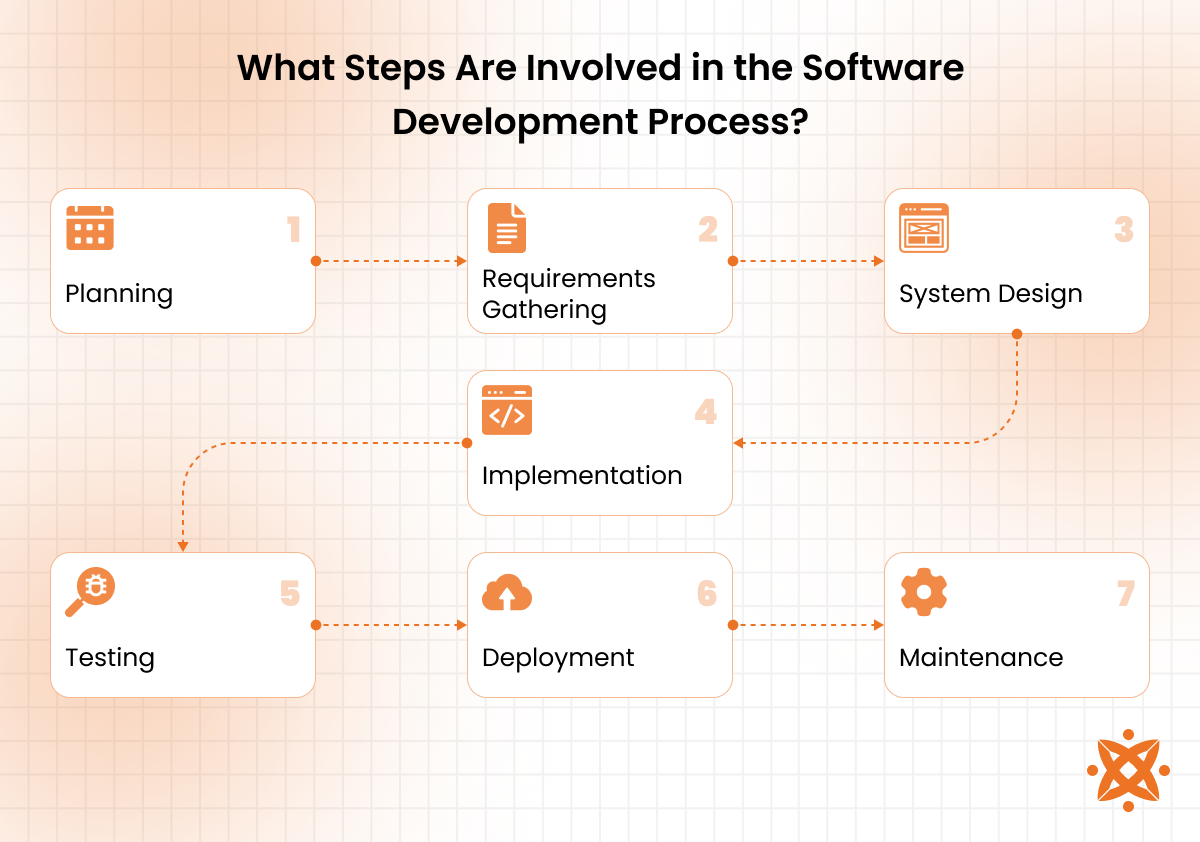
The steps involved in the software development process are as follows:
- Planning
- Requirements Gathering
- System Design
- Implementation
- Testing
- Deployment
- Maintenance
Planning
Planning is the first step of the Software Development Life Cycle. It involves defining project goals, scope, and feasibility, creating a roadmap, identifying resources, and establishing timelines to ensure the project aligns with business objectives.
Requirements Gathering
In the requirements-gathering phase, stakeholders collaborate to determine the software';s functional and non-functional requirements. Detailed documentation is created to guide the development process, ensuring the final product meets user expectations.
System Design
System design involves structuring the software';s architecture, user interfaces, and data workflows. This step defines the blueprint for developers, incorporating elements like database models, APIs, and user interface specifications.
Implementation
Implementation is the coding phase, during which developers write the software based on the design specifications. Using appropriate programming languages and tools, this phase transforms plans into functional applications.
Testing
Testing ensures the software is free of bugs and meets quality standards. Various tests, including unit, integration, and user acceptance testing, are conducted to validate functionality, performance, and security.
Deployment
Deployment is the process of releasing software to end users. It involves configuring production environments and ensuring a smooth transition from development to operation.
Maintenance
Maintenance involves updating and optimising the software to address user feedback, fix bugs, and adapt to changing needs. This ongoing phase is necessary to extend the software';s lifecycle and maintain its relevance in a dynamic environment.
What is the Difference Between Software Development and Programming?
The main difference between software development and programming is that software development encompasses the entire process of creating software, and programming is primarily focused on writing and debugging code.
Software development involves planning, designing, testing, and maintaining software, ensuring it meets user needs and is scalable. Programming, on the other hand, is a subset of software development. In this subset, the focus is on translating design specifications into functional code using specific programming languages. Other differences include the broader responsibilities of software developers, such as collaboration with stakeholders and ensuring project alignment with business goals, compared to programmers, who concentrate on technical implementation.
What is the Difference Between Software Development and Apps Development?
The main difference between software development and app development is that app development specifically focuses on creating software for mobile or desktop applications, whereas software development has a broader scope, including system software, embedded software, and enterprise solutions.
App development revolves around designing user-friendly interfaces and optimising performance for platforms like Android or iOS. Software development encompasses backend systems, cloud computing, and more. Apps involve platform-specific tools like Swift or Kotlin, and software development utilises a wider range of technologies for diverse applications.
What is the Difference Between Software Development and Web Development?
The main difference between software development and web development is that software development involves creating all kinds of software, including applications for offline use. Web development focuses exclusively on building websites and web-based applications.
Web development requires expertise in front-end and back-end technologies like HTML, CSS, JavaScript, and frameworks like React or Django. In contrast, software development includes a variety of fields, such as game development, embedded systems, and cybersecurity.
Software developers work on standalone systems requiring complex architectures, whereas web developers prioritise web compatibility and user experience on browsers.
What is the Difference Between Software Development and Software Engineering?
The main difference between software development and software engineering is that software engineering applies engineering principles to the software development process, emphasising system design, scalability, and reliability. Software development focuses more on the practical aspects of creating and coding software.
Software engineering involves addressing large-scale system challenges, such as ensuring fault tolerance and optimising resource utilisation.
Software development, by contrast, emphasises delivering functional applications based on user requirements. Both roles overlap. Software engineers also have responsibilities in hardware integration and rigorous testing protocols.
What is the Difference Between Software Development and Cybersecurity?
The main difference between software development and cybersecurity is that software development focuses on creating and maintaining software, and cybersecurity concentrates on protecting systems, networks, and software from threats and vulnerabilities.
Cybersecurity involves safeguarding digital assets through practices like penetration testing, encryption, and monitoring for anomalies. Software development, on the other hand, contains secure coding practices but primarily aims to deliver functional and user-friendly software. Both fields collaborate. Cybersecurity experts are tasked with proactive risk mitigation, whereas developers focus on innovation and feature implementation.
What is the Difference Between Software Development and Computer Science?
The main difference between software development and computer science is that computer science is an academic discipline that studies the theoretical foundations of computing, and software development is a practical process of building software applications.
Computer science explores algorithms, computational theory, and areas like artificial intelligence and data science.
Software development applies these theories to create real-world applications. Computer scientists conduct research or design new computing paradigms. Software developers concentrate on solving specific business or user problems through software solutions.
Can AI be Used in Software Development?
Yes, AI can be used in software development to improve efficiency, automate repetitive tasks, and improve decision-making.
AI-powered tools assist with code generation, bug detection, and project management. For example, platforms like GitHub Copilot leverage machine learning to suggest code snippets, while AI algorithms simplify testing by identifying patterns in error logs.
AI is used to optimise software architecture, process natural language for user interfaces, and use predictive analytics to anticipate user needs.
How To Choose a Development Software Company?
To choose a software development company, evaluate its expertise, reputation, and ability to understand your project requirements.
Begin by reviewing its portfolio to assess the quality and relevance of its previous projects. Look for client testimonials or case studies to determine their reliability.
Consider its technological expertise, ensuring it has experience with the tools and platforms your project demands. Transparency in communication, clear pricing structures, and a commitment to deadlines are also required.
If you're based in the UK, consider partnering with a reputable software development company UK, known for its proven track record in delivering innovative and efficient software solutions.
What are the Software Development Best Practices?
The software development best practices include Agile development, continuous integration, automated testing, code reviews, and modular design.
Agile development ensures flexibility by allowing iterative improvements during the development cycle. Continuous integration automates merging code changes, preventing integration issues.
Automated testing identifies errors early, reducing debugging time. Code reviews improve quality by encouraging collaboration and catching potential flaws.
Modular design promotes scalability and maintainability by breaking software into smaller, manageable components. Implementing these practices results in efficient, high-quality software.
What is the Cost of Developing Software?
The cost of developing software ranges from £20,000 to over £400,000, depending on its complexity, features, and scale, according to a study by Tekrevol in “How Much Does Software Development Cost in the UK?” Simple applications with limited functionality cost between £20,000 and £50,000. Medium-complexity software projects range from £50,000 to £150,000, while advanced systems, such as enterprise-level solutions or AI-integrated platforms, exceed £400,000.
The development platform influences software development costs. For example, native applications (specific to iOS or Android) cost more than cross-platform solutions.
Team location also plays a significant role; according to a report by IT Jobs Watch, UK developers charge between £500 and £600 per day.
Design complexity, such as advanced user interfaces or machine learning features, significantly increases costs.
Ongoing maintenance adds 15–20% annually to the initial development cost, covering updates, security enhancements, and feature expansions.
Over the life of the software, maintenance accounts for as much as 90% of the total cost of ownership (TCO), according to a study by Science Soft in “Software Maintenance and Support.”
What are the Common Software Development Principles?
The common software development principles are DRY (Don';t Repeat Yourself), KISS (Keep It Simple, Stupid), SOLID principles, and YAGNI (You Aren';t Gonna Need It). DRY emphasises avoiding redundancy in code and improving maintainability. KISS advocates simplicity in design to reduce complexity.
SOLID principles provide guidelines for creating scalable and robust object-oriented software. YAGNI discourages over-engineering by focusing only on necessary features. Adhering to these principles ensures cleaner, more efficient, and sustainable software development.
How Long Does Software Development Take?
Software development takes 3 to 18 months, depending on project size and complexity, according to a study by Forbes.
For simple applications, the process takes 3 to 6 months and covers basic design, development, and testing phases.
Medium-complexity projects range from 6 to 12 months.
Enterprise-level or highly advanced software requires 12 to 18 months or more due to intricate functionality and rigorous testing.
Timelines depend on factors like team size, technology stack, and iterative adjustments during the development lifecycle.
A larger team expedites timelines but requires more coordination, potentially introducing delays. The choice of technology is also important, as modern frameworks and tools facilitate development.
Iterative adjustments in Agile or DevOps methodologies involve continuous feedback and refinement, ensuring a high-quality final product but extending timelines.
External factors such as client approvals, compliance requirements, and third-party integrations significantly influence the duration of the project.
Never Miss an Update From Us!
Sign up now and get notified when we publish a new article!
Tuhin Bhatt
Co-Founder
Tuhin Bhatt is a co-founder of Intelivita, a leading Web and Mobile App Development Company with offices in the UK and India. He has expertise in Mobile Game, iOS, Android, AR and VR app technologies. With flawless command over mobile app development, Tuhin also has a passion to share his expertise with clients and other enthusiasts. His write-ups are usually based on Technology, Leadership, and Entrepreneurship.

